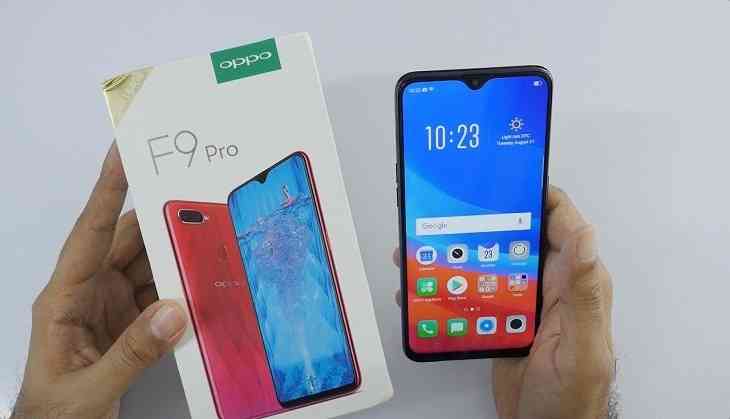
Chinese smartphone manufacturer Oppo was one of the first Android original equipment makers (OEMs) to introduce a smartphone with an iPhone X-like notch-based screen. With the launch of the Oppo F9 Pro, it also became the first brand to introduce a screen with a tiny notch. A phone with a waterdrop design, the F9 Pro has a notch of the size of a water drop, and it accommodates only the front camera. The earpiece and sensors have been moved to the thin bezel area above it. Though the phone has a fresh design with a new screen format on the front and glass with a gradient design on the back, it is the phone’s fast-charging capability that gives it an edge in the midrange smartphone segment. The phone features Oppo’s proprietary VOOC fast-charging technology, which according to the company provides two hours of talk time in five minutes’ charge.
Business Standard reviewed the Oppo F9 Pro to test its overall performance and the VOOC charging technology. Here are our observations:
Design and display
The Oppo F9 Pro looks identical to its predecessor, the Oppo F7. However, with a new screen format on the front and a gradient glass design on the back, the phone looks refreshing and has a premium appeal. The back of the smartphone looks dazzling, especially with its gradient design giving it a 3D look. However, with the fingerprint sensor placed in the middle-centre and horizontally aligned dual-camera module on the top-left-centre, the back lacks a uniform look and is, therefore, cluttered.
The front is dominated by a new 6.3-inch screen format of the fullHD+ resolution, stretching in a 19:9 aspect ratio. The screen has a tiny notch screen area accommodating just the front camera. Interestingly, the earpiece now sits under a thin bezel above the display, along with sensors on its right. The new screen format gives the phone a tall look, making it somewhat difficult to operate it using one hand.
Oppo F9 Pro Being an LCD unit, the display is bright and has good sunlight legibility. It has a good saturation and contrast ratio. However, the colour rendition is not satisfactory and a fullHD+ resolution on such a big panel looks a bit pixelated, especially while reading text, playing games and watching videos.
Camera
The smartphone has a dual-camera module on the back featuring a 16-megapixel primary sensor, mated with a 2MP depth-sensing lens. The main camera has a large f/1.8 aperture size and the depth-sensing lens sits behind f/2.4 aperture. The camera fixes autofocus quickly and takes detailed shots in all light conditions. However, in low light, the camera softens the output and shows noise across the frame.
Oppo F9 Pro On the front, the phone has a 25MP lens behind an f/2.0 aperture. The selfie camera is best suited for portrait shots. It supports auto HDR, which allows the camera to take better images even with bright backgrounds.
Performance
Powering the smartphone is the midrange MediaTek Helio P60 system-on-chip (SoC), mated with 6 GB of RAM and 64 GB of storage, expandable using a dedicated microSD card. The processor is not a powerhouse, but it packs enough to run things smoothly. The phone boots Android Oreo out of the box, covered under ColorOS 5.2, a highly customised skin packed with a lot of bloatware. The interface is far from stock, so it takes time getting used too. It is not the best-looking user interface, as the icons appear to be a cheap adaptation of the iOS. In terms of usability, the OS is difficult to operate, especially for users who have not used Oppo smartphones earlier.
Coming to the performance, the Oppo F9 Pro is a mixed bag of hits and misses. The performance is mostly smooth, but gaming apps like Asphalt 9 and PUBG show the processor’s limitations with respect to graphics. It does manage to run such graphic-intensive games but only when the graphics are set to medium or low. The phone warms up after excessive gaming sessions. It also shows thermal inefficiency when used for longer calls, but not to a point where it might become unbearable to hold and operate.
Powering the smartphone is a 3,500 mAh battery, which keeps the phone going for almost a day. Gaming, video streaming and camera take a toll on battery, but the phone shows a promising on-battery performance of more than 10 hours. Battery charging time is also quick — the phone's battery goes from zero to 100 per cent in less than two hours which is good. The company’s claim of two hours of talk time in a five-minute charge seems a little exaggerated. However, the phone manages to charge enough battery for an hour of calling.
Verdict
Priced at Rs 23,990, the Oppo F9 Pro is a mixed bag of hits and misses in the midrange smartphone segment. The phone’s refreshing design, smooth performance and fast-charging technology give it an edge over other smartphones in the same segment. However, thermal issues and underperforming camera module put a serious question on its overall capabilities. But these issues seem software glitch that might be addressed in a future software upgrade.


